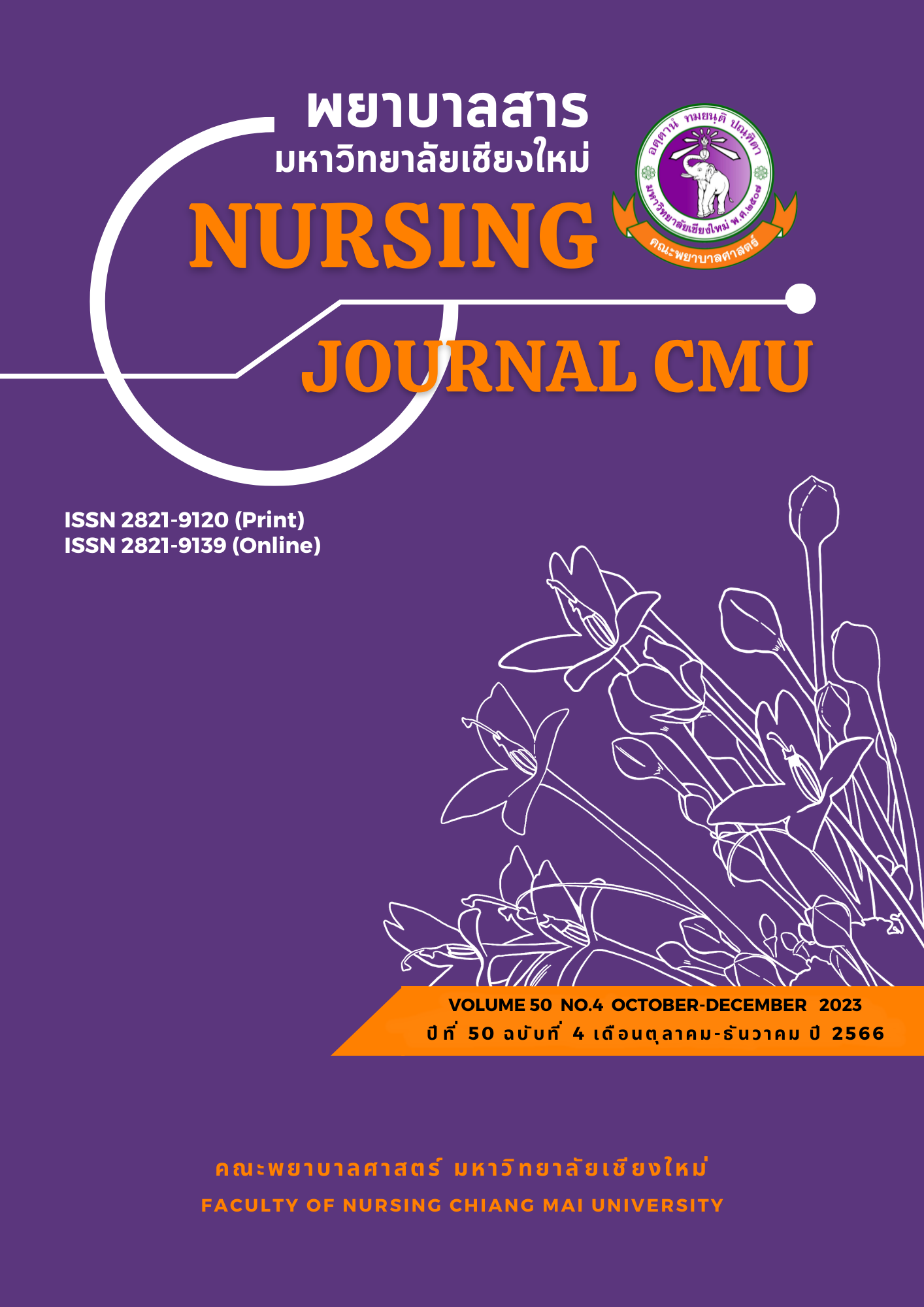Development and Testing the Effectiveness of Emergency Department Critical Trauma Management Model Implementation
Keywords:
Critical trauma, Critical trauma management, Emergency departmentAbstract
Proper initial management of critically ill trauma patients by multidisciplinary teams at emergency departments (ED) is crucial. This implementation study aimed to develop an ED Critical Trauma Management Model (EDCTM model) and to test its effectiveness on ED management duration and the mortality rate among critically ill trauma patients. The conceptual framework for EDCTM model development and implementation consisted of the clinical practice guidelines of the National Health and Medical Research Council (NHMRC), Australia. The three groups of samples in this study were as follows: 1) the model developer group included 4 participants (1 physician and 3 nurses); 2) the model user group consisted of 20 participants (6 physicians and 14 nurses); and 3) the critically ill trauma patient group consisted of 159 participants (110 persons before the model implementation and 49 persons during the model implementation). Information regarding the process and results of the ED critically ill trauma patient management was recorded in the OPServ program which was part of the hospital healthcare information system.
The findings from the study revealed the following.
1. The EDCTM Model included 3 ED management phases: 1) ED preparation phase, 2) ED management phase, and 3) ED discharge preparation phase. The ISBAR was applied thoroughly for information handover wherever appropriate;
2. The EDCTM Model implementation decreased the mean of ED management duration from 74.51 (SD = 34.77) minutes to 59.76 (SD = 26.58) minutes; and decreased critical ill trauma patients’ mortality rate from 16.36% to 6.12%.
The EDCTM model has shown its effectiveness in critically ill trauma management in this study. It should be continuously implemented, and yearly outcomes should be evaluated to prove its sustainability and effectiveness.
References
Abu-Zidan, F. M. (2016). Advanced trauma life support training: How useful it is? World Journal of Critical Care Medicine, 5(1), 12-16. https://doi.org/10.5492/wjccm.v5.i1.12
Alimenti, D., Buydos, S., Cunliffe, L., & Hunt, A. (2019). Improving perceptions of patient safety through standardizing handoffs from the emergency department to the inpatient setting: A systematic review. Journal of the American Association of Nurse Practitioners, 31(6), 354-363.
American College of Surgeons. (2018). Advance trauma life support (10th ed.). https://pubhtml5.com/oxsy/uctd/ATLS_10th_Edition_Student_Manual/
American Heart Association. (2020). Highlights of the 2020 American Heart Association guidelines for CPR and ECC. https://cpr.heart.org/-/media/cpr-files/cpr-guidelines-files/highlights/ hghlghts_2020_ecc_guidelines_english.pdf
Behghadami, M. A., Janati, A., Sadeghi-Bazargani, H., Gholizadeh, M., Rahmani, F., & Arab-Zozani, M. (2019). Assessing preparedness of non-hospital health centers to provide primary emergency care; A systematic review. Bulletin of Emergency & Trauma, 7(3), 201.
Burgess, A., Van Diggele, C., Roberts, C., & Mellis, C. (2020). Teaching clinical handover with ISBAR. BMC Medical Education, 20(2), 1-8.
Damrongchitti, P., Srisanit, R., & Duangdee, P. (2014). Development of nursing practice guideline for major trauma patient in Chaophya Abhaibhubejhr Hospital. Journal of Public Health Nursing, 28(1), 43-54. (in Thai)
Engebretsen, S., Bogstrand, S. T., Jacobsen, D., & Rimstad, R. (2021). Quality of care, resource use and patient outcome by use of emergency response team compared with standard care for critically ill medical patients in the emergency department: A retrospective single centre cohort study from Norway. BMJ Open, 11(8), e047264. https://doi.org/10.1136/bmjopen-2020-047264
Gurger, M., Turkoglu, A., Atescelik, M., Turgay, B. O. R. K., Tokdemir, M., Alatas, O. D., & Ekingen, E. (2014). Sudden suspected death in emergency department: Autopsy results. Turkish Journal of Emergency Medicine, 14(3), 115-120.
Hietbrink, F., Smeeing, D., Karhof, S., Jonkers, H. F., Houwert, M., van Wessem, K., Simmermacher, R., Govaert, G., de Jong, M., de Bruin, M., & Leenen, L. (2019). Outcome of trauma-related emergency laparotomies, in an era of far-reaching specialization. World Journal of Emergency Surgery, 14, 40. https://doi.org/10.1186/s13017-019-0257-y
Joanna Briggs Institute. (2014). New JBI levels of evidence. http://joannabriggs.org/assets/docs/ approach/JBI-Levels-of-evidence_2014.pdf
Kashani, P., & Saberinia, A. (2019). Management of multiple traumas in emergency medicine department: A review. Journal of Family Medicine and Primary Care, 8(12), 3789–3797. https://doi.org/10.4103/jfmpc.jfmpc_774_19
Kraysubun, C. (2018). Effect of development of trauma system on outcome of major trauma patient in Prachinburi Province. Burapha Journal of Medicine, 5(1), 28-35. (in Thai)
Liu, J., Masiello, I., Ponzer, S., & Farrokhnia, N. (2018). Can interprofessional teamwork reduce patient throughput times? A longitudinal single-centre study of three different triage processes at a Swedish emergency department. BMJ Open, 8(4), e019744.
Nantachaipan, P. (2006). The CPGs. quality evaluation questionnaire. Faculty of Nursing, Chiang Mai University. (in Thai)
National Health and Medical Research Council. (1999). A guide to the development implementation and evaluation of clinical practice guidelines. http://www.health.gov.au/nhmrc/publication/pdf/cp.30.pdf
National Institute for Emergency Medicine. (2021). Annual report 2020 (1st ed.). Ultimat Printing. https://www.niems.go.th/pdfviewer/index.html (in Thai)
Peterson, C., Miller, G. F., Barnett, S. B. L., & Florence, C. (2021). Economic cost of injury-United States, 2019. Morbidity and Mortality Weekly Report, 70(48), 1655-1686. https://www.cdc.gov/mmwr/volumes/70/wr/pdfs/mm7048a1-H.pdf
Pornchensuanpong, C., La-or, P., & Boonchoo, K. (2016). The development of an evidence based practice care model for traumatic injury patients in Nakhon Nayok Hospital. Nursing Journal of the Ministry of Public Health, 20(2), 89-102. (in Thai)
Raja, A., & Zane, R. D. (2016). Initial management of trauma in adults. UpToDate. https://www.uptodate.com/contents/initial-management-of-trauma-in-adults
Strategy and Planning Division. (2021). KPI template report 2020 (3rd ed.). Ministry of Public Health. http://bps.moph.go.th/new_bps/sites/default/files/template62_edit3.pdf (in Thai)
Thipthimwong, K. (2020). Development of emergency life support guideline for Thung Saliam Hospital. Journal of Sciences and Technology Northern, 1(2), 56-68. (in Thai)
Victorian State Trauma System. (2017). Teamwork and communication guideline. https://trauma.reach.vic.gov.au/guidelines/teamwork-and-communication/key-messages.
World Health Organization. (2019). WHO mortality database. Interactive platform visualizing mortality data report 2020. https://platform.who.int/mortality/about/about-the-who-mortality-database
Downloads
Published
How to Cite
Issue
Section
License
Copyright (c) 2023 Nursing Journal

This work is licensed under a Creative Commons Attribution-NonCommercial-NoDerivatives 4.0 International License.
บทความที่ได้รับการตีพิมพ์เป็นลิขสิทธิ์ของวารสารพยาบาลสาร
ข้อความที่ปรากฏในบทความแต่ละเรื่องในวารสารวิชาการเล่มนี้เป็นความคิดเห็นส่วนตัวของผู้เขียนแต่ละท่านไม่เกี่ยวข้องกับมหาวิทยาลัยเชียงใหม่ และคณาจารย์ท่านอื่นๆในมหาวิทยาลัยฯ แต่อย่างใด ความรับผิดชอบองค์ประกอบทั้งหมดของบทความแต่ละเรื่องเป็นของผู้เขียนแต่ละท่าน หากมีความผิดพลาดใด ๆ ผู้เขียนแต่ละท่านจะรับผิดชอบบทความของตนเองแต่ผู้เดียว






